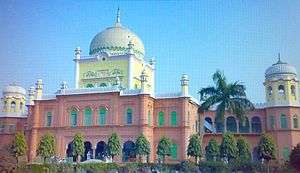Muhammad Ilyas Kandhlawi
| Part of a series on |
| The Deobandi movement |
|---|
 Darul Uloom Deoband, India |
| Ideology and influences |
| Founders and key figures |
| Notable institutions |
| Centres (Markaz) of Tabligh |
| Associated Organizations |
| Militant Organisations |
Muḥammad Ilyās ibn Muḥammad Ismā‘īl Kāndhlawī Dihlawī (Urdu: محمد الیاس بن محمد اسماعیل کاندھلوی دہلوی) was an Indian Islamic scholar and Sufi who founded the Tablighi Jamaat Islamic revivalist movement. H is buried outside the Tablighi Masjid, in the Nizamuddin area, Delhi, India.
Name and lineage
He was Muhammad Ilyas ibn Muhammad Ismail, Kandhlawi (of Kandhla) by birth and origin, then Dihlawi (of Delhi).
Early life and education
Muhammad Ilyas was born in 1303 AH (1885/1886) in the village of Kandhla, Muzaffarnagar district, North-West Provinces, British India (in present-day Shamli district, Uttar Pradesh, India). His year of birth can be computed by the tarikhi (chronogrammatic) name "Akhtar Ilyas" (اختر الیاس) using abjad numerals.[1]
He was the son of Muhammad Ismail and his second wife, Safiyah.[1]
In a local maktab he memorized one and a quarter ajza' of the Qur'an, and he completed memorizing the Qur'an under his father in Nizamuddin area, Delhi. Thereafter, he studied the elementary books of Arabic and Persian language mostly under his father.[1]
Later on helived with and studied under Rashid Ahmad Gangohi. In 1905, the death of Rashid Ahmad Gangohi occurred, when Ilyas was 20. In 1908, Ilyas enrolled in Darul Uloom Deoband.
Foundation of Tablighi Jamaat
In the early 1920s, he prepared a team of young madrasah graduates from Deoband and Saharanpur and sent them to Mewat to establish a network of mosques and Islamic schools movement but once said that if he had to attribute a name to his movement, it would have been Tehreek-e-Imaan (Imaan/Faith movement'). The people of South Asia started calling the devotees Tableeghi and this name became popularised eventually.
Sources
- Nadwi, Abu'l-Hasan `Ali. Life and Mission of Maulana Muhammad Ilyas.
- "Hazrat Maulana Mohammad Ilyas Sahab Rh.". Madrasa Islamia Arabia Khadimul-Uloom Baghonwali and Bajheri. Retrieved 28 July 2012.
- Yoginder Sikand (17 April 2010). "The Tablighi Jamaat in Mewat -- Part 2". TwoCircles.net. Retrieved 28 July 2012.
References
- 1 2 3 Sayyid Abul-Ḥasan ‘Alī Nadwī (n.d.) [First published c. 1947]. حضرت مولانا محمد الیاس اور ان کی دینی دعوت / Ḥaẓrat Maulānā Muḥammad Ilyās aur un kī dīnī da‘wat (in Urdu). Rā’ewind [Raiwind]: Maktabah Maḥmūdīyah.